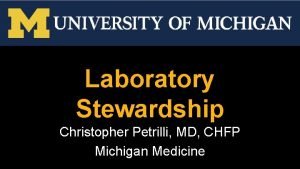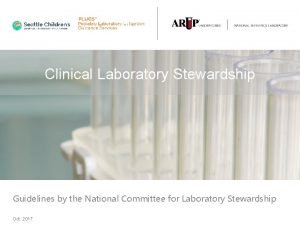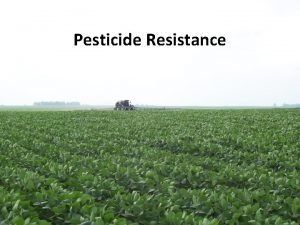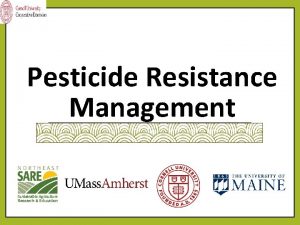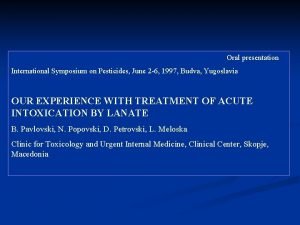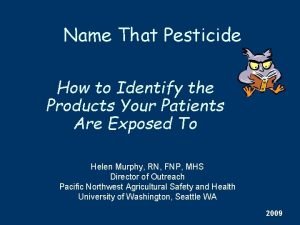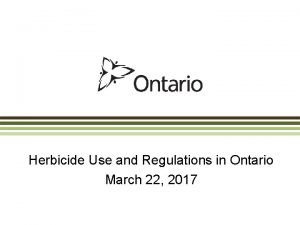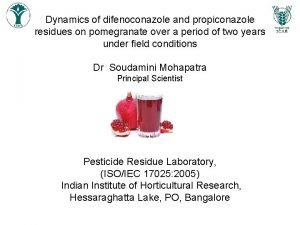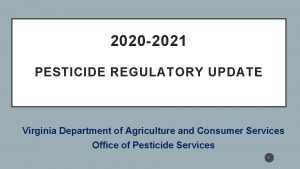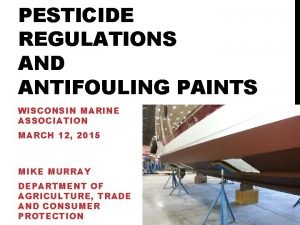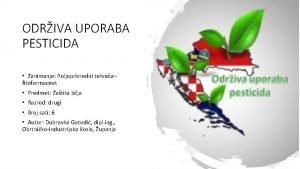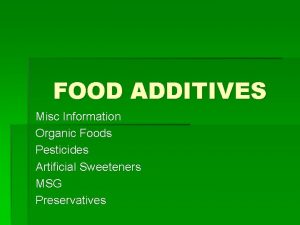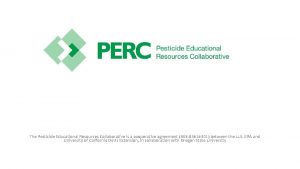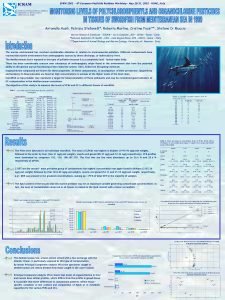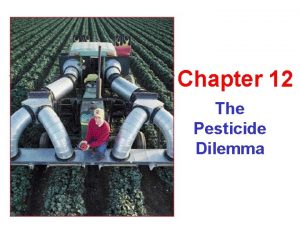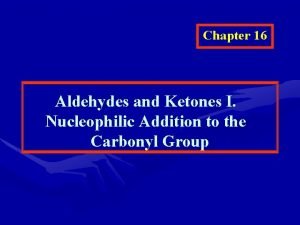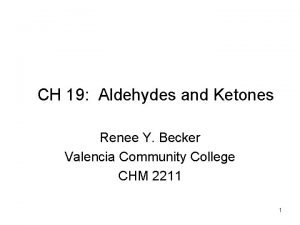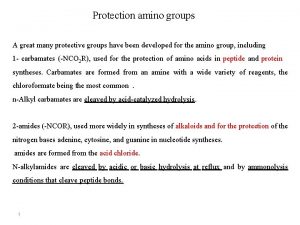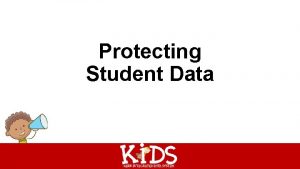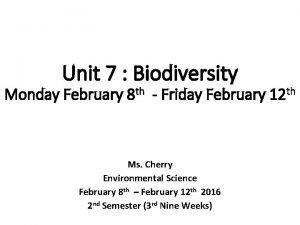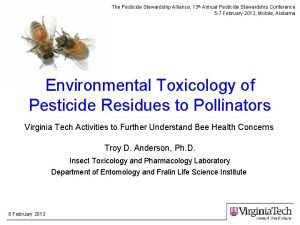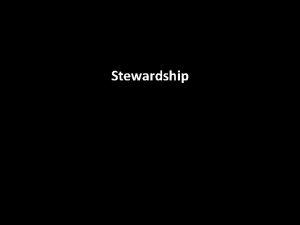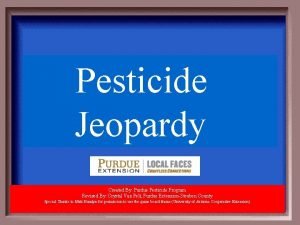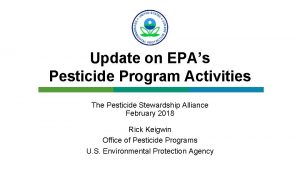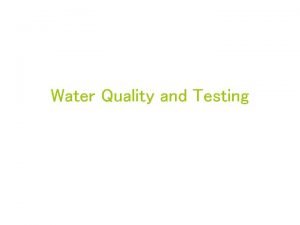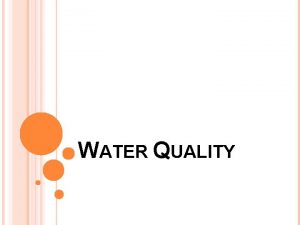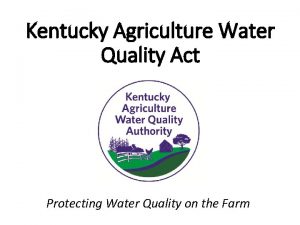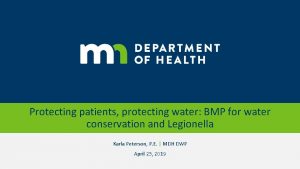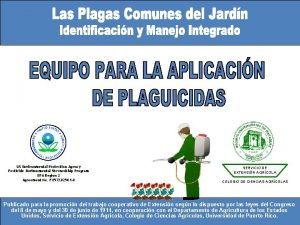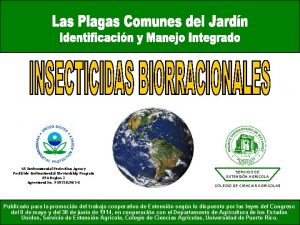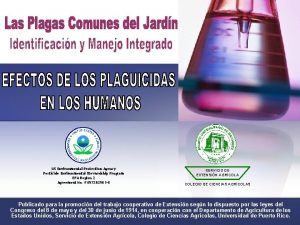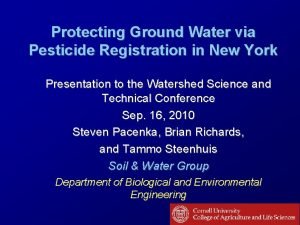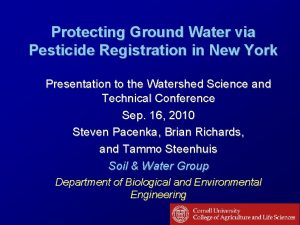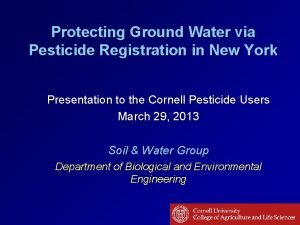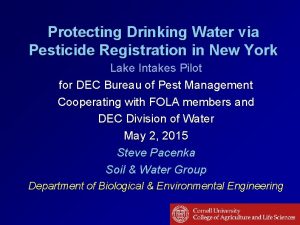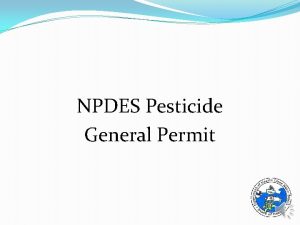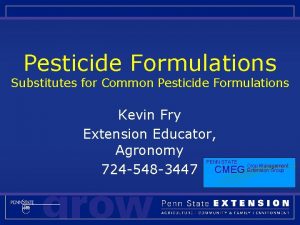Pesticide Stewardship Partnership Program Protecting Water Quality through































- Slides: 31

Pesticide Stewardship Partnership Program: Protecting Water Quality through Collaboration Program Update – Oregon Pesticide Symposium Kevin Masterson, Oregon DEQ masterson. kevin@deq. state. or. us

Pesticide Stewardship Partnerships (PSPs) Collaborating at the watershed level Key Steps in Partnership Projects Monitor for current use pesticides in surface waters from drift & runoff Identify streams with elevated pesticide concentrations or high # of detections Collaborate to implement voluntary management practices Follow-up monitoring to determine improvements over time

“Non-Point” Pesticide Water Quality Risks Multiple Use Sites Rural Forestry Right-of-way Recreation Landscaping Urban Homes


Water monitoring sites often from atop or below roadway bridges - Runoff from roadway and adjacent land use activities

Collaborative Inter-Agency Approach 2007 Water Quality Pesticide Management Team Coordinate to prevent / reduce… • Currently registered pesticides in… • Surface and groundwater resulting from… • Agricultural and non-Agricultural uses Awareness & Voluntary Collaborative Solutions

Oregon Pesticides of Interest (POIs) National List (EPA) 57 Pesticides of Interest + Local List (OR) 16 Additional Pesticides Selection Factors • Pesticide properties 73 “Pesticides of Interest” (POIs) Smaller List of “Pesticides of Concern” (POCs) • persistence, toxicity, etc. • Use (what, where, when) • Historical detections • Other “weight-of-evidence” Needs Updating! Last Revised in 2012 -13

New PSP Program Developments: Program Expansion and Evolution

Pesticide-related Water Quality Management: Stable Funding for PSP Program • 2013 Oregon Legislature allocated resources to: 1. To add new watersheds to program and support & enhance monitoring in existing PSP watersheds 2. To conduct pesticide waste collection events during biennium (7 -10 events over two years). 3. To provide stewardship technical assistance support • Similar 2015 -17 Legislative Allocation ($1. 695 m): • • Continued surface water monitoring, and some sediment monitoring in 9 watersheds 3 collection events in Eastern Oregon in Fall 2015, and several more planned in 2016 -17 Multiple local technical assistance grant proposals funded PSP “Partner” grants to support sample collection &

2016 Pesticide Stewardship Partnerships: 9 Oregon Watersheds 2014 -15 Pilot Monitoring in: • Middle Rogue • Middle Deschutes • South Umpqua • South Coast Recent Program Emphasis: Ensure a diverse array of land uses are represented Newest PSP – 2016 baseline monitoring underway

PSP Monitoring Data: Successes and 2015 Data Findings

(86%) Only 2 weeks of monitoring in 2010 malathion use season Cherry growers increasing use of weather stations to reduce wind drift & use more ground (rather than aerial) spraying near streams (19%)

Max = 18. 9 ug/l In 2012, irrigation district switched to mechanical weed controls and spot spraying of a less toxics and persistent herbicide Max < 0. 1 ug/l

Clackamas Watershed PSP Program (2014) The Oregonian, December 1, 2014


What Types of Actions Have Been Implemented to Produce Results? • Spray Drift Reduction Trainings & Practices • Installation of Weather Stations • Use of Biological Controls (e. g. , mating disruption) • Integrated Pest Management Training & Technical Assistance • Use of Less Toxic Pesticides • Buffer Strips & Minimize Spraying near Streams


Evaluation of Monitoring Data by Inter-Agency Team 1. Compare Detections to EPA Aquatic Life Benchmarks (ALB) • Most sensitive acute & chronic toxicity data for each group of organisms • Non-regulatory values that help ID & prioritize pesticides & locations Rainbow trout Fathead minnow Bluegill sunfish Daphnia magna Green algae Duckweed 2. Aquatic Life Ratio: • Detected Concentration (ug/L) / Lowest Acute or Chronic ALB Values ≥ 1. 0 indicate a potential concern and need for further attention 3. Other “weight-of-evidence” factors: • Frequency of detections, number of pesticides in a single sample (mixtures) Bifenthrin (chronic invertebrate) Sulfometuron Diuron Chlorpyrifos methyl (acute (chronic (acute non-vascular) fish) vascular) 0. 0013 ug/L 0. 041 ug/L 0. 45 ug/L 2. 4 ug/L Imazapyr (acute vascular) 24 ug/L

100. 00 Pesticide Detection Frequency 2014 Middle Rogue Pesticide Monitoring 90. 00 no benchmark over benchmark 80. 00 Most detected pesticides can be used for a wide range of ag, urban and forestry uses. 70. 00 50 -100% 10 -50% detects <10% of benchmark Frequency (%) 60. 00 50. 00 40. 00 30. 00 20. 00 10. 00 Am in om et hy DE l be lo ch 4, 4´ -D ni yr ap Di az on Im az ur rfl No se th yla tra zin e ET DE ar rb Ca De op pr iso De yla tra or lu zin fe n e yf id zin Ox ra At am ip r -D et 2, 4 Ac id pr lo Im id am nz be ro lo ich 6 D ac hy et -m on ur et m lfo id e l te sa ho yp (A M PA Gl Su 2, lp ho sp h on ic ac id Di ur on ) 0. 00




Refining Existing PSP Monitoring Program Example: Yamhill PSP (West Fork Palmer Creek) Partners: Yamhill SWCD, Greater Yamhill Watershed Council, local growers

Waste Pesticide Collection: Oregon PSP Program Pesticide Collection Events 2014 -2015 9 Events: 235 Participants, 145, 616 lbs. Cornelius* March 8, 2014 29 participants 15, 822 lbs Mc. Minnville Dec. 6, 2014 54 participants 39, 218 lbs. Dallas May 22, 2015 25 participants 23, 970 lbs. Coos Bay May 9, 2015 15 participants Medford 11, 244 lbs. Mar. 7, 2015 25 participants 10, 585 lbs. Hermiston Oct. 2014 14 participants 8600 lbs. Madras Nov. 2014 17 participants 10, 467 lbs. Milton-Freewater July 2014 30 participants 15, 150 lbs. Ontario Oct. 2014 26 participants 10, 560 lbs. * Partial PSP funding for locally-sponsored event in Cornelius Plus, sponsorship of 2 other events at permanent facilities in Hood River and La. Grande Compare to WA State: >2. 8 million lbs. since 1988 24

Waste Pesticide Collections Medford/White City March 7, 2015 10, 585 lbs. collected $1. 15 $1. 39 DDT: Banned by EPA in 1972 DDT banned by EPA in 1972

Di-Syston (OP insecticide) 1958 Mobay 1954 Miles in 1992 Bayer 1995 Paraquat (ICI 1962) Niagara pre 1943 (1927? ) Division of FMC in 1946 Probably changed labels to FMC after 1961

2016 Free Pesticide Waste Collection Events • March 4 in Grants Pass & March 5 in White City • April 15 – Pendleton: Pendleton Convention Center, 1601 Westgate • April 28 – Philomath: Oregon Department of Forestry Offices, 24533 Alsea Hwy • April 29 – Harrisburg: Harrisburg High School, 400 S 9 th St, Harrisburg, OR 97446 • June 3 – Lakeview: Lake County Roads Department, 95574 Highway 140 West • Fall Events: Tillamook, Roseburg, Mc. Minnville

PSP Technical Assistance Grants for Existing PSP Watersheds Guiding Principles

Technical Assistance in Existing PSP Watersheds 2014 Theme: Spray Optimization/Drift Reduction A. OSU Extension: Orchard Spray Optimization & Calibration Project (Hood River, OR) B. Yamhill SWCD: “Tunnel Sprayer” for spray optimization & drift reduction on small fruit The Patternator Plans to expand to Wasco and Walla PSPs C. Launched a Pesticide Stewardship Grant Program


-Thank You Questions
 Water and water and water water
Water and water and water water Lab stewardship program
Lab stewardship program Laboratory stewardship program
Laboratory stewardship program Define pesticide resistance
Define pesticide resistance Xxxxxxxxxx xxxxxxxxx
Xxxxxxxxxx xxxxxxxxx Lanate pesticide
Lanate pesticide Pesticide classification chart
Pesticide classification chart Pesticide warning signs ontario
Pesticide warning signs ontario Agriculture pesticide difenoconazole
Agriculture pesticide difenoconazole Virginia pesticide registration
Virginia pesticide registration Wisconsin pesticide applicator license
Wisconsin pesticide applicator license Tablica miješanja pesticida
Tablica miješanja pesticida Organic food additives
Organic food additives Pesticide educational resources collaborative
Pesticide educational resources collaborative European pesticide residue workshop
European pesticide residue workshop Types of pesticides
Types of pesticides Obtaining and protecting your credit
Obtaining and protecting your credit Chapter 9 obtaining and protecting your credit
Chapter 9 obtaining and protecting your credit Chapter 20 civil liberties protecting individual rights
Chapter 20 civil liberties protecting individual rights Reactions of aldehydes and ketones summary
Reactions of aldehydes and ketones summary Aldehyde protecting group
Aldehyde protecting group Carbamate protecting group
Carbamate protecting group John procter quotes
John procter quotes Chapter 9 obtaining and protecting your credit
Chapter 9 obtaining and protecting your credit Protecting student data
Protecting student data Protecting consumers savers and investors examples
Protecting consumers savers and investors examples Biodiversity tends to decrease nearer the equator.
Biodiversity tends to decrease nearer the equator. Species diversity
Species diversity Chapter 20 civil liberties protecting individual rights
Chapter 20 civil liberties protecting individual rights Chapter 20 civil liberties protecting individual rights
Chapter 20 civil liberties protecting individual rights Stewardship
Stewardship Tithes verse tagalog
Tithes verse tagalog

